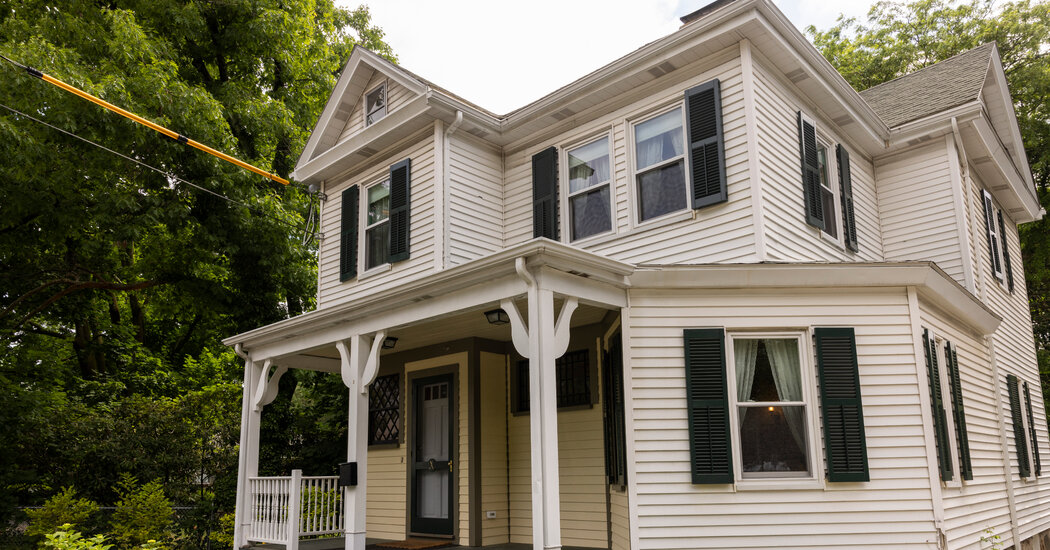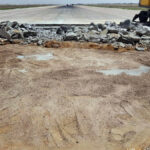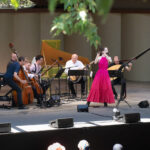
BROOKLINE, Mass. — The small, 19th-century home with the golf course view is hardly noticeable to the hundreds of drivers whizzing by at 40 miles an hour on Clyde Street in the Boston suburb of Brookline. While the two-story house once stood like a sentry overlooking acres of cow pasture, the neighborhood is now replete with luxury housing, four-lane roads and a bustle worthy of a community just seven miles from downtown.
The location does not look like a landmark to the birthplace of American golf. But it is, in ways both tangible and symbolic. This week, the site will be newly in the spotlight as the U.S. Open returns for a fourth time to the Country Club in Brookline.
Neighbors of the Clyde Street property have recently noticed a flurry of activity at the residence as contractors’ vans filled the driveway daily for what is clearly a moneyed restoration project. In late April, two workers peeled back attic ceiling panels of the 1893 dwelling and then had to duck as a pair of antique golf clubs tumbled to the floor.
“They’re Francis’s clubs!” one of the workers, Aldeir Filho, yelped. His colleague Christian Herbet dashed down the stairs to alert the crew of tradesmen below.
From the second floor, Herbet shouted: “We found Mr. Ouimet’s clubs.”
In 1913, Francis Ouimet, then a 20-year-old self-taught amateur golfer, left the second-floor bedroom he shared with his brother at 246 Clyde Street and crossed the street to the Country Club, where he defeated the world’s two most accomplished British professionals, Ted Ray and Harry Vardon, to win the U.S. Open.
The stunning upset by Ouimet, the son of immigrants and a caddie at the club, was front-page news across the nation and has been credited with spawning explosive nationwide growth in the game. While there were only 350,000 American golfers in 1913, that number had swelled to 2.1 million less than 10 years later. The fame of Ouimet’s groundbreaking accomplishment — no amateur had ever won the U.S. Open and few golfers from working-class roots had ever played in championships — has endured for 109 years, no doubt helped by a popular 2005 movie, “The Greatest Game Ever Played.”
The house that Ouimet’s father, Arthur, just happened to purchase across from the Country Club has often played a prominent factor in Francis Ouimet’s winsome story. The humble dwelling astride a tony country club came to represent the two worlds Ouimet daringly traversed when he walked down his unadorned wooden front steps and marched onto the club’s gilded grounds for the last 18 holes of the 1913 U.S. Open. About four hours later, he was carried from the last green on the shoulders of cheering fans. The duality of Ouimet’s life on either side of Clyde Street, including the cramped, meager confines of his upbringing, is a robust part of the narrative. There are, for example, 17 scenes depicting life in the Ouimet house in the 2005 movie.
And yet, until recently, preserving or formally recognizing the home’s significance was never a priority. While the structure remained in the Ouimet family for 94 years, it changed ownership multiple times. The exterior and interior were altered and a tall white fence rose in the front yard to eclipse most of the ground floor from the road.
As housing prices in Brookline soared across the decades, some people at the nearby club, which is a founding member of the United States Golf Association, worried what might happen if the property was bought and redeveloped. Years ago, for instance, what had been the family barn next to the Ouimet house was sold, rebuilt and turned into condominiums.
“If you let that house be torn down,” Fred Waterman, the club historian, said of the Ouimet house in an interview last month, “you’ve allowed a very important part of American sports history to disappear.”
Tom Hynes, a member of the Country Club who has a Boston real estate background that stretches to the 1960s, casually befriended the owners of the house, Jerome and Dedie Wieler, not long after they moved to the neighborhood in 1989. Hynes lives nearby and would see the Wielers walking their dog almost daily.
“When you’re ready to sell your house,” Hynes told the couple, “I’m your buyer.”
The Wielers answered that they were not selling and were curious why Hynes would want it. Hynes explained Ouimet’s history to the Wielers, who knew nothing of golf. But the Wielers were intrigued by a heartwarming story.
“Someday, maybe 20 years from now, you might be selling and please let me know,” said Hynes, who added that he would remind the Wielers about once a year. “I just wanted the house returned to golf.”
Late in 2020, the Wielers contacted Hynes, who set foot in the house at 246 Clyde Street for the first time and 30 minutes later had a handshake agreement to buy the property for $875,000.
Hynes set about trying to defray the purchase cost by raising money with the intent of donating the house to the club, which could use it for myriad activities, including staff and guest housing on the second floor. The decision was also made to restore the house to make it appear as it did when the Ouimets lived there in 1913.
“When you walk into the house we want you to have the feeling of what it was like to have walked into the family’s home 109 years ago,” Waterman said.
But first, there was much work to do. While the house was in good shape, it needed innumerable improvements to meet modern building codes. The cost of the restoration swelled. As Hynes, the nephew of a three-term Boston mayor who has brokered some of the city’s most sweeping real estate deals, said: “I started going around town with my tin cup out.”
Hynes had a potent, almost divine ally in his fund-raising mission. It was as if Francis Ouimet was mystically assisting him. Ouimet, who died in 1967, remained a lifelong resident of the Boston area and continued to win golf championships as an amateur for many years after 1913. He also had a career in finance.
In 1949, a Ouimet college scholarship program for caddies was created. Since then, the Ouimet Fund has awarded nearly $44 million to more than 6,300 men and women. The need-based scholarships can be worth as much as $80,000 across four years of study.
As Hynes began to solicit help for his restoration, he occasionally was surprised to find donors who were unflinchingly generous with their money. They were Ouimet Scholars, now middle-aged, who believed they would have never attended college without the fund’s assistance.
Additionally, more than 40 members of the Country Club have contributed, most donating $25,000 each. The first phase of the renovation was finished last week.
A tour of the 1,550-square-foot, six-room Ouimet house these days is like stepping back in time since its appearance has been curated to match an early-20th-century style. The wallpaper, lighting, drapes and shades are vintage. The furnishings are faithful to the period: chairs, sofas and tables from the early 1900s presented to the club by an architect who heard about the renovation. Common rooms were small then, but add to the cozy, familial feel.
Just inside the first-floor entry is an old, preserved wooden wall telephone, the kind with a crank on the side. It is rigged so visitors can lift the receiver and hear a recording of Ouimet describing his U.S. Open victory. He is joined on the audiotape by Eddie Lowery, who was Ouimet’s 10-year-old caddie. The two remained lifelong friends.
Elsewhere on the first floor are mementos acknowledging what took place nearby in 1913, including newspaper clippings and photographs. The tall, imposing street-side fence has been removed to reveal newly planted sod with a border of perennials.
The second phase, which will renovate the building’s exterior by adding new clapboard, windows and a cedar shingle roof, will not be complete until next year. After that, Hynes hopes to hand off the house to the club. Since the club, which has about 1,300 members, has yet to take possession of the Ouimet house, its president, Lyman Bullard, said there was no decision yet on access or its primary use.
Hynes, who mentioned being sensitive to neighbors of a property in a residential area, does not envision the house being open to the public, or offering tours like a museum. But Waterman felt there might be a sense of obligation to share the house, and its history, in some way.
In the movie “The Greatest Game Ever Played,” there is an early bit of foreshadowing: a scene of the young Francis Ouimet dutifully but surreptitiously practicing his putting at night after his parents had gone to bed. If that might be Hollywood mythmaking, there is no disputing the golf-centric, stirring view from Ouimet’s second-floor bedroom window. Across Clyde Street, Francis could see the Country Club’s pristine 17th hole. The vista now is altered by the decades-long growth of trees sprouting on the perimeter of the grounds. But standing at the bedroom window, with the house’s revitalized original flooring creaking underfoot, the manicured 17th hole is still plainly visible.
Francis Ouimet’s boyhood dreams seem present, not distant.
His impact on golf, even American sport, is alive in the spirit of his home.
In 1913, the golf icon Gene Sarazen, then known as Eugenio Saraceni, was an 11-year-old caddie in the New York suburbs. The son of Sicilian immigrants, he read about Ouimet’s stunning victory over the renowned British professionals. As Waterman noted, Sarazen said to himself at the time: “If he can do it, I can do it.”
When Sarazen was 20, like Ouimet, he won the U.S. Open, the first of the seven major golf championships he won from 1922 to 1935.
For Waterman and Hynes, one of their fondest hopes is that the Ouimet house, newly returned to golf, is not done influencing future U.S. Open champions. Hynes floated the possibility that one of the golfers in this year’s field might wish to stay in the house during the competition.
Calling that “the ultimate thing,” Waterman added: “It would be a player who says, ‘I want to wake up in Francis Ouimet’s bedroom because he walked down the stairs and won the U.S. Open. Maybe that’s what will happen for me.’ ”




